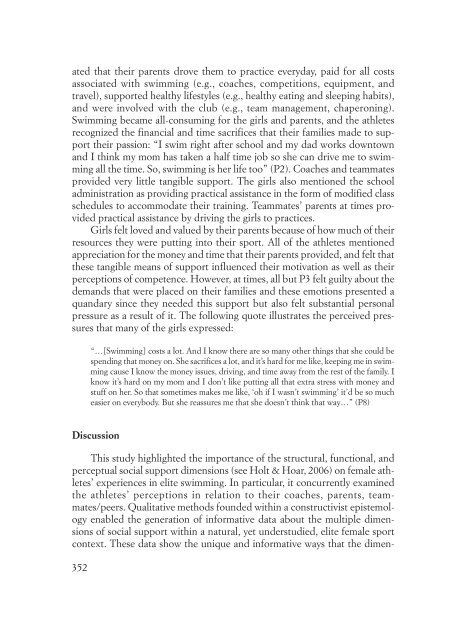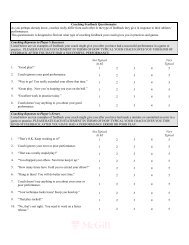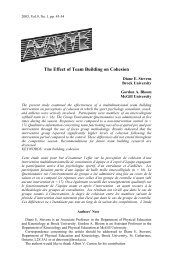International Journal of Sport Psychology
International Journal of Sport Psychology
International Journal of Sport Psychology
You also want an ePaper? Increase the reach of your titles
YUMPU automatically turns print PDFs into web optimized ePapers that Google loves.
ated that their parents drove them to practice everyday, paid for all costs<br />
associated with swimming (e.g., coaches, competitions, equipment, and<br />
travel), supported healthy lifestyles (e.g., healthy eating and sleeping habits),<br />
and were involved with the club (e.g., team management, chaperoning).<br />
Swimming became all-consuming for the girls and parents, and the athletes<br />
recognized the financial and time sacrifices that their families made to support<br />
their passion: “I swim right after school and my dad works downtown<br />
and I think my mom has taken a half time job so she can drive me to swimming<br />
all the time. So, swimming is her life too” (P2). Coaches and teammates<br />
provided very little tangible support. The girls also mentioned the school<br />
administration as providing practical assistance in the form <strong>of</strong> modified class<br />
schedules to accommodate their training. Teammates’ parents at times provided<br />
practical assistance by driving the girls to practices.<br />
Girls felt loved and valued by their parents because <strong>of</strong> how much <strong>of</strong> their<br />
resources they were putting into their sport. All <strong>of</strong> the athletes mentioned<br />
appreciation for the money and time that their parents provided, and felt that<br />
these tangible means <strong>of</strong> support influenced their motivation as well as their<br />
perceptions <strong>of</strong> competence. However, at times, all but P3 felt guilty about the<br />
demands that were placed on their families and these emotions presented a<br />
quandary since they needed this support but also felt substantial personal<br />
pressure as a result <strong>of</strong> it. The following quote illustrates the perceived pressures<br />
that many <strong>of</strong> the girls expressed:<br />
352<br />
“…[Swimming] costs a lot. And I know there are so many other things that she could be<br />
spending that money on. She sacrifices a lot, and it’s hard for me like, keeping me in swimming<br />
cause I know the money issues, driving, and time away from the rest <strong>of</strong> the family. I<br />
know it’s hard on my mom and I don’t like putting all that extra stress with money and<br />
stuff on her. So that sometimes makes me like, ‘oh if I wasn’t swimming’ it’d be so much<br />
easier on everybody. But she reassures me that she doesn’t think that way…” (P8)<br />
Discussion<br />
This study highlighted the importance <strong>of</strong> the structural, functional, and<br />
perceptual social support dimensions (see Holt & Hoar, 2006) on female athletes’<br />
experiences in elite swimming. In particular, it concurrently examined<br />
the athletes’ perceptions in relation to their coaches, parents, teammates/peers.<br />
Qualitative methods founded within a constructivist epistemology<br />
enabled the generation <strong>of</strong> informative data about the multiple dimensions<br />
<strong>of</strong> social support within a natural, yet understudied, elite female sport<br />
context. These data show the unique and informative ways that the dimen-




